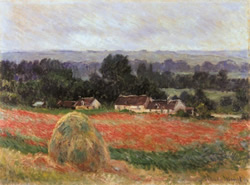
The
poppy field
Claude Monet, 1886
In
Flanders fields the poppies blow
Between the crosses, row on row,
That mark our place; and in the sky
The larks, still bravely singing, fly
Scarce heard amid the guns below.
We
are the Dead. Short days ago
We lived, felt dawn, saw sunset glow,
Loved and were loved, and now we lie
In Flanders fields...
From “In Flanders Fields” by John Macrae, 1915
Throughout Western Europe, wild poppies spring up when the earth is disturbed, and the destruction unleashed by the Napoleonic wars of the early 19th Century transformed bare land into fields of blood red poppies, a sight unfortunately revisited in 1914 when the First World War churned up Flanders and northern France.
Recounting the story of the death of Adonis, ancient Greeks told of scarlet anemones blooming wherever a drop of his blood had landed. The Canadian surgeon John McCrae found a similar significance in the poppy, immortalising it as a lasting memorial to the fallen in his poem “In Flanders Fields”. Nowadays, in the weeks before Remembrance Sunday, small paper or silk poppies are on sale, the proceeds going towards the care of wounded ex-service people.
Early on the morning of 11 November 1918, an armistice was signed in the Forest of Compiegne in France, thus ending World War I after four years of conflict between the Germans and the Allies. The moment the armistice was signed, an order was issued for all firing to cease. Weapons were laid down, whistles were blown, places of business were closed and there were impromptu parades as rejoicing spread round the globe. In remembrance of this, at 11 am each year, on the Sunday nearest to 11 November, a service is held at the Cenotaph in London to commemorate British and Commonwealth servicemen and women who died in the two World Wars and subsequent conflicts.
The Cenotaph was designed and built by Edwin Lutyens in 1919 at the request of then Prime Minister Lloyd George. Meaning “empty tomb” in Greek, the Cenotaph was initially a wood and plaster construction intended only for the first anniversary of the armistice. However, at its unveiling observers spontaneously covered the base of the monument in wreaths. Such was the extent of public enthusiasm that it was decided it should become a permanent and lasting memorial; the temporary construction was replaced by one made of Portland stone, simply inscribed with the words “The Glorious Dead”.
The service on Remembrance Sunday has changed little since it was first introduced in 1921: hymns are sung, prayers are said and a two minute silence is observed. Officials lay wreaths at the base of the Cenotaph, and the ceremony ends with war veterans marching past in a gesture of respect for their fallen comrades. This is repeated in cities, towns and villages throughout the country as special church services are held, along with parades around local war memorials.